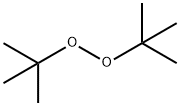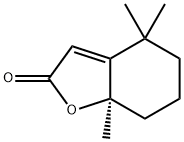tert-Butyl peroxide , 97% , 110-05-4
Synonym(s):
tert-Butyl peroxide;Di-tert-butyl peroxide;Di-tert-butyl peroxide;tert-Butyl peroxide
CAS NO.:110-05-4
Empirical Formula: C8H18O2
Molecular Weight: 146.23
MDL number: MFCD00008803
EINECS: 203-733-6
PRODUCT Properties
| Melting point: | -30 °C |
| Boiling point: | 109-110 °C(lit.) |
| Density | 0.796 g/mL at 25 °C(lit.) |
| vapor pressure | 40 mm Hg ( 20 °C) |
| refractive index | n |
| Flash point: | 34 °F |
| storage temp. | Store at +15°C to +25°C. |
| solubility | 0.063g/l |
| form | Liquid |
| color | Clear |
| Odor | distinctive odor |
| Water Solubility | immiscible |
| Merck | 14,3461 |
| BRN | 1735581 |
| Stability: | May decompose explosively if heated, subjected to shock, or treated with reducing agents. Highly flammable. Refrigerate. |
| InChIKey | LSXWFXONGKSEMY-UHFFFAOYSA-N |
| LogP | 3.2 at 22℃ |
| CAS DataBase Reference | 110-05-4(CAS DataBase Reference) |
| NIST Chemistry Reference | Di-tert-butyl peroxide(110-05-4) |
| EPA Substance Registry System | Di-tert-butyl peroxide (110-05-4) |
Description and Uses
Di-tert-butyl peroxide is a clear, water-white liquid. It has a specific gravity of 0.79, which is lighter than water, and it will float on the surface. It is nonpolar and insoluble in water. Di-tert-butyl peroxide is a strong oxidizer and may ignite organic materials or explode if shocked or in contact with reducing agents. In addition to being an oxidizer, Di-tert-butyl peroxide is highly flammable. It has a boiling point of 231°F (110°C) and a flash point of 65°F (18°C). The NFPA 704 designation is health 3, flammability 2, and reactivity 4. The prefix “oxy” for oxidizer is placed in the white section at the bottom of the 704 diamond.
The decomposition reaction proceeds via the generation of methyl radicals. The peroxide bond undergoes homolysis at temperatures above 100 °C. Hence di-tert-butyl peroxide is commonly used as a radical initiator in organic synthesis and polymer chemistry. DTBP can in principle be used in engines where oxygen is limited, since the molecule supplies both the oxidizer and the fuel.
Safety
| Symbol(GHS) |   GHS02,GHS08 |
| Signal word | Danger |
| Hazard statements | H225-H242-H341-H412 |
| Precautionary statements | P210-P220-P273-P280-P410-P411+P235 |
| Hazard Codes | O,F,Xn |
| Risk Statements | 7-11-68-52/53-2017/7/11 |
| Safety Statements | 14-16-3/7-36/37/39-14A-61-23 |
| RIDADR | UN 3107 5.2 |
| WGK Germany | 1 |
| RTECS | ER2450000 |
| Autoignition Temperature | 182 °C |
| HS Code | 2909 60 00 |
| HazardClass | 5.2 |
| PackingGroup | II |
| Hazardous Substances Data | 110-05-4(Hazardous Substances Data) |
| Toxicity | LD50 orally in Rabbit: > 25000 mg/kg |




